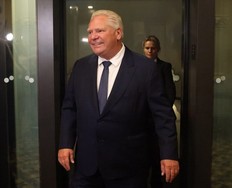GOLDSTEIN: Canada’s targets for cutting greenhouse gases fit the definition of insanity

Article content
After almost four decades of Canadian governments setting and failing to hit eight consecutive targets for reducing Canada’s industrial greenhouse gas emissions, surely it’s time to admit the targets are meaningless.
Far from being “aspirational” as supporters claim, they in fact deceive Canadians about the effectiveness of federal spending of more than $200 billion of taxpayers’ money on climate change (as of 2023) on 149 federal programs administered by 13 government departments, since the Liberal government came to power in 2015.
In fact, Liberal and Conservative governments have been setting and failing to meet emission reduction targets since 1988.
Given 37 years of ongoing failures, these targets now fit the definition of insanity — doing the same thing over and over again, expecting different results.
Here’s where things stand given the latest available federal government emissions data that comes from 2023.
Canada’s current emission reduction target was set by then prime minister Justin Trudeau in 2021 — a goal of reducing Canada’s emissions to at least 40% (and, ideally, up to 45%) below 2005 levels in 2030.
According to the federal government, which retroactively changes the historical data every year based, it says, on improved data-gathering methods, Canada emitted 759 million tonnes of these gases in 2005.
That means the government’s target is to cut Canada’s emissions to 455 million tonnes (40% below 2005 levels) and, ideally, to 417 million tonnes (45% below 2005 levels) in 2030.
Canada’s emissions in 2023 were 694 million tonnes which is 8.5% below 2005 levels.
To meet the minimum federal target of reducing emissions to 455 million tonnes in 2030 would require cutting 2023 emissions by 239 million tonnes.
That would mean the equivalent of shutting down Canada’s entire old and gas sector (208 million tonnes of annual emissions in 2023) in 2030 and still coming up short.
To reach the government’s interim target of reducing emissions to 20% below 2005 levels in 2026 (meaning 607 million tonnes) would require a cut of 87 million tonnes of emissions by next year, more than all emissions from Canada’s buildings sector in 2023 (82.7 million tonnes).
Earlier this year, the government announced another unrealistic target of reducing emissions to 45%-50% of 2005 levels by 2035.
A report by federal environment commissioner Jerry DeMarco following an audit of the Liberals’ Net Zero Emissions Accountability Act last year said it was still possible for the government to achieve its 2030 target, “but now the task is much harder because there are only six years left to do essentially 20 or 30 years worth of reductions.”
His findings, however, provided few grounds for optimism.
DeMarco said the government’s lack of transparency made it impossible for the average citizen to understand, much less believe, its emission reduction targets.
It claims current policies will achieve a 36.2% reduction in emissions compared to 2005 in 2030, close to its minimum target of 40%.
But when DeMarco’s auditors examined a sampling of 20 of the government’s 149 measures to cut emissions, they found only nine were on track to achieve their goals.
Of 32 additional measures the government claimed would help boost reductions from 36.2% to at least 40% in 2030, only seven were new.
The audit found cases where two different programs were funding the same projects and reporting the same expected emission reductions, raising the possibility of double-counting.
It also reported the computer modelling used to estimate the emission cuts of various government programs wasn’t updated in 2023 compared to 2022 and that some of the initial calculations were overly optimistic.
In addition, “recent decreases to projected 2030 emissions were not due to climate action taken by governments, but were instead because of revisions to the data used in modelling.”
Given all this, if the Liberals under Prime Minister Mark Carney won’t abandon unrealistic climate targets then they should at least come clean with Canadians about where things really stand.
This as opposed to their current practice of insisting they’re on track to meet their targets when the federal government’s own data tell a very different story.
It’s the same problem with the Liberals’ policy to mandate that 20% of all new car sales must be battery-electric, plug-in hybrid or hydrogen fuel cell starting next year, rising to 60% in 2030 and 100% in 2035.
The auto sector has warned that given lagging EV sales in Canada, the only way to achieve the 2026 target would be to pull a million new gas-powered vehicles off the market, limiting consumer choice, increasing delivery times and driving up costs for consumers at a time when our auto sector is under siege from Donald Trump’s tariffs.













Postmedia is committed to maintaining a lively but civil forum for discussion. Please keep comments relevant and respectful. Comments may take up to an hour to appear on the site. You will receive an email if there is a reply to your comment, an update to a thread you follow or if a user you follow comments. Visit our Community Guidelines for more information.